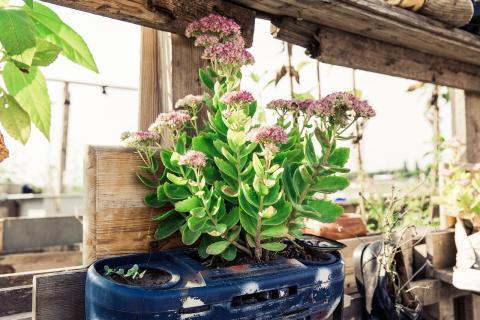
Not everyone has a green thumb. But if you really want some green(ery) around, here are some tips and tricks for the lazy gardener in you.
I love to have a garden, but there’s only so much digging, prodding, poling, pruning, cutting, planting, and watering I can do in a day. Agreed that working with soil is very healthy for you, and getting the kids to help brings them close to nature as well—there are just so many hours in a winter's day! So here are some tips and tricks I learned from the best, picked up from gardening sites and groups and otherwise managed to think of myself. Hope they help you become a smarter gardener and decrease your workload all that much, too!
A Planted Pot-In-A-Pot
The headline sounds complicated but the trick is darn simple, especially when winter flowers give way to spring blooms, and spring blooms wither away to let in the summer blossoms! Once you have demarcated the space in which you want your flower bed to be, dig in pot-sized holes and wedge in an earthen pot in that space. Create your own potted design. Now simply plant your seeds or seedlings in smaller pots that can fit into those large pots, or buy potted blooms from your local nursery. All you have to do is slip in the potted blooms in your buried pot holders—and switch the pots when the plants wither or die. Easy, convenient, and beautiful for the garden as well.
Planting A Crop? Use Eggshell Beds
When you are about to plant a new crop and want to go the seedling way, plant those little seeds into eggshell cups. All you have to do is eat your eggs by breaking open the shell at the top and leaving a “bowl” shaped shell to plant your seeds in with a little potting soil. Once the seedlings can withstand being shifted to a flower bed, just dig in a hole and drop in the seedling along with the eggshell – you get a bumper crop because of all that egg-stra calcium!
Tired of Midnight Rodents & Nibblers?
If your green and leafy produce are getting nibbled on by chipmunks, rabbits, and all sorts of rodents, you can protect your crop by strategically planting some plastic forks around your crop. Just wedge in the fork at about the same height as your crop, tines facing up. The rodents will cease and desist once they get poked and prodded enough by the sharp but harmless plastic tines.
Want A Raised Garden? Look At Cinder Blocks
Cinder blocks can really come in handy if you want an elevated garden bed without the hassle of carpeting in or cementing up a trough. Plus the divisions or holes mean you can separate your herbs and use each division as a separate pot or flower bed. You can even place them to form a rectangle or a square and fill in the gap in the center with more soil to make that into an even larger elevated bed.
Want to Turn Your Rose Trimmings Into Plants?
So for those of us who didn’t know, rose trimmings can be turned into whole new plants. Once you trim the branches, snip off all leaves and buds and leave them bare but with the thorns intact. Now insert the part you want to plant into the soil into a small potato and then plant it, potato and all, into the soil. Why the potato? It keeps the end of the trimming warm and moist and helps it take root while the “shoot” does its best to make more leaves and grow as it should.
Need A Greenhouse For Seedlings?
Seedlings need some extra carbon dioxide at times to grow into tough and hardy plant-lings that can then be transferred into soil beds. To give them that little extra help, halve your empty cola bottles (maintaining a 10-15 cm length). Now once you have planted the seeds in eggshells or even halved citrus shells, cover them with the plastic dome and see the growth double.
Finally, Add In A Dry Creek For Beauty & Drainage
Plagued by heavy rains and poor drainage? We have an easy solution for you that looks as beautiful as it is handy. Dig in a trench in a path-like winding way in your garden. Now use riverbed stones to fill up this indent. Your garden will look like it has a little river bed running through it and this will not only add some great visual appeal but also help drain water from otherwise soggy soil beds into the “creek”. Make sure your creek has an outlet that helps drain the water out and away—build it in a slant.
Hope these simple, doable tips help you turn your garden from drab to fab—and make you want to spend time burying your hands in the soil and smelling the roses!








